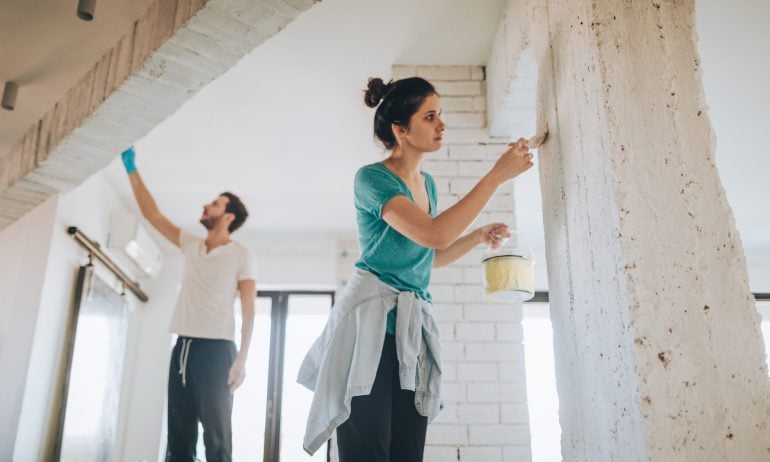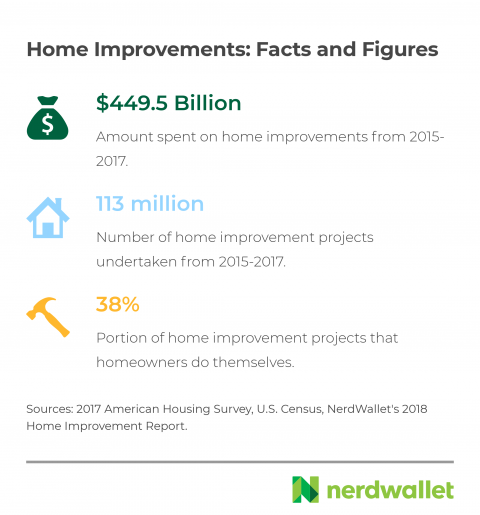Some or all of the mortgage lenders featured on our site are advertising partners of NerdWallet, but this does not influence our evaluations, lender star ratings or the order in which lenders are listed on the page. Our opinions are our own. Here is a list of our partners.
It’s safe to say, all homeowners have experience with home repairs and improvements — whether they’re tackled with vigor and a generous budget or they languish on the to-do list indefinitely.
Americans spent nearly $450 billion in home improvement projects from 2015 through 2017, according to the most recent American Housing Survey from the U.S. Census Bureau. These projects included everything from gutting and renovating kitchens and bathrooms to adding a backyard shed or a home security system. Some homeowners scraped their savings when unexpected repairs came up, and some others took out home equity loans to remodel in hopes of increasing the value of their castles. These projects varied from house to house, neighborhood to neighborhood, and city to city.
NerdWallet’s 2018 Home Improvement Report took a bird’s-eye view of home improvement projects, analyzing national spending data and gauging consumer sentiment with a nationally representative survey. But we were also interested in localized numbers, so took a closer look at improvements in the country's 15 biggest metro areas.
“Each city has its own vibe and way of doing things, including home improvements,” says NerdWallet home expert Holden Lewis. “I mean, Detroit has Greek food and snow, and Dallas has Mexican food and hail. And they're different in how much homeowners spend on home improvements, what kinds they do and how often they tackle do-it-yourself projects. Like food, culture and weather, all cities have their differences when it comes to home improvements.”
» CALCULATOR: Estimate the cost of your home improvement project
Home improvement project costs
How much you spend on a home improvement project depends on many factors — the cost of materials, the going rate contractors are charging, and whether you opt for budget-friendly or high-end renovations. And many of these factors vary by location.
Looking solely at the median cost of home improvement projects tells a limited story. Typical project costs in the New York City metro area are among the highest, according to the census, but incomes there are higher as well, making those costs easier to cover.
Instead, we’ve applied the median project cost to the median household income of owner-occupied homes in 15 large metropolitan areas, giving us a sense of how affordable these projects actually are. For example, as in New York City, homeowners in Dallas are typically spending $2,000 on their home improvement projects. But in Dallas, those projects account for 2.2% of the median household income versus 1.9% in New York City. Now, that may not seem like a big difference, but that 0.3% of annual income represents an additional $270 per project in Dallas.
Median home improvement project costs as a percent of household income
Location | Median project cost | % of income |
|---|---|---|
United States | $1,350 | 1.8% |
Atlanta-Sandy Springs-Roswell, GA | $1,500 | 1.8% |
Boston-Cambridge-Newton, MA-NH | $2,000 | 1.8% |
Chicago-Naperville-Elgin, IL-IN-WI | $1,500 | 1.7% |
Dallas-Fort Worth-Arlington, TX | $2,000 | 2.2% |
Detroit-Warren-Dearborn, MI | $1,200 | 1.6% |
Houston-The Woodlands-Sugar Land, TX | $1,500 | 1.7% |
Los Angeles-Long Beach-Anaheim, CA | $1,700 | 1.7% |
Miami-Fort Lauderdale-West Palm Beach, FL | $1,500 | 2.1% |
New York-Newark-Jersey City, NY-NJ-PA | $2,000 | 1.9% |
Philadelphia-Camden-Wilmington, PA-NJ-DE-MD | $1,500 | 1.7% |
Phoenix-Mesa-Scottsdale, AZ | $1,200 | 1.6% |
Riverside-San Bernardino-Ontario, CA | $1,200 | 1.5% |
San Francisco-Oakland-Hayward, CA | $1,750 | 1.3% |
Seattle-Tacoma-Bellevue, WA | $1,500 | 1.4% |
Washington-Arlington-Alexandria, DC-VA-MD-WV | $2,000 | 1.6% |
Home improvement project rate
The largest cities in our analysis will understandably have more home improvement projects — there are more people working on more homes. But coming up with the number of projects per owner-occupied home gives us a way to fairly compare homeowners in different cities.
The American Housing Survey looks at a period of approximately two years — see the methodology below for more details — so the rates represented below are for a two-year period. For example, across the country, homeowners undertook 113 million home improvement projects, or 1.47 per owner-occupied home, from 2015 to 2017.
Home improvement projects per owner-occupied home, 2015-2017
Location | Projects | Projects per owner-occupied unit |
|---|---|---|
United States | 113,000,000 | 1.47 |
Atlanta-Sandy Springs-Roswell, GA | 1,993,000 | 1.51 |
Boston-Cambridge-Newton, MA-NH | 1,732,000 | 1.54 |
Chicago-Naperville-Elgin, IL-IN-WI | 3,398,000 | 1.51 |
Dallas-Fort Worth-Arlington, TX | 2,210,000 | 1.44 |
Detroit-Warren-Dearborn, MI | 1,915,000 | 1.63 |
Houston-The Woodlands-Sugar Land, TX | 1,966,000 | 1.39 |
Los Angeles-Long Beach-Anaheim, CA | 2,877,000 | 1.37 |
Miami-Fort Lauderdale-West Palm Beach, FL | 1,426,000 | 1.14 |
New York-Newark-Jersey City, NY-NJ-PA | 3,794,000 | 1.02 |
Philadelphia-Camden-Wilmington, PA-NJ-DE-MD | 2,386,000 | 1.58 |
Phoenix-Mesa-Scottsdale, AZ | 1,718,000 | 1.61 |
Riverside-San Bernardino-Ontario, CA | 989,600 | 1.17 |
San Francisco-Oakland-Hayward, CA | 1,399,000 | 1.51 |
Seattle-Tacoma-Bellevue, WA | 1,379,000 | 1.54 |
Washington-Arlington-Alexandria, DC-VA-MD-WV | 2,506,000 | 1.79 |
Homeowner DIY rate
Across the nation, homeowners skip hiring a professional in 38% of home improvement projects. But whether they’re trying to save money or they just like to get their hands dirty, a full 43% of homeowners say they’ve screwed up a DIY home improvement project at least once in the past, according to NerdWallet’s survey.
Homeowners in Riverside, California, have the highest DIY rate of all metros analyzed, at 43%. Those in Dallas are most likely to hire a pro, with only 26% of their projects done by the homeowners’ hands.
Rate of DIY projects as a percent of total home improvement projects
Location | DIY rate |
|---|---|
United States | 38% |
Atlanta-Sandy Springs-Roswell, GA | 28% |
Boston-Cambridge-Newton, MA-NH | 29% |
Chicago-Naperville-Elgin, IL-IN-WI | 32% |
Dallas-Fort Worth-Arlington, TX | 26% |
Detroit-Warren-Dearborn, MI | 40% |
Houston-The Woodlands-Sugar Land, TX | 35% |
Los Angeles-Long Beach-Anaheim, CA | 29% |
Miami-Fort Lauderdale-West Palm Beach, FL | 29% |
New York-Newark-Jersey City, NY-NJ-PA | 29% |
Philadelphia-Camden-Wilmington, PA-NJ-DE-MD | 29% |
Phoenix-Mesa-Scottsdale, AZ | 31% |
Riverside-San Bernardino-Ontario, CA | 43% |
San Francisco-Oakland-Hayward, CA | 27% |
Seattle-Tacoma-Bellevue, WA | 39% |
Washington-Arlington-Alexandria, DC-VA-MD-WV | 23% |
Spending less with DIY
Homeowners generally spend less on projects they DIY, and there are likely a few reasons for this. First, they’re more likely to do simple projects themselves, and simple projects are generally less expensive. For instance, only the most ambitious homeowner would DIY a new roof, but far more may take on a minor kitchen remodel or landscaping project. Secondly, DIY means no labor costs. Except, of course, for the pizza to feed friends who are pitching in.
Some of the most dramatic differences in DIY versus professional spending come from the Dallas metro area, where DIY costs are on par with the national median but the typical amount spent hiring a professional is significantly higher. In some metros, such as New York and Boston, homeowners spend far more than the national median, whether they’re hiring a professional or doing it themselves.
Median spending on professional vs. DIY home improvement projects
Location | Pro cost | DIY cost | Amount saved |
|---|---|---|---|
United States | $2,408 | $600 | $1,808 |
Atlanta-Sandy Springs-Roswell, GA | $2,200 | $600 | $1,600 |
Boston-Cambridge-Newton, MA-NH | $3,000 | $1,000 | $2,000 |
Chicago-Naperville-Elgin, IL-IN-WI | $2,000 | $700 | $1,300 |
Dallas-Fort Worth-Arlington, TX | $3,000 | $600 | $2,400 |
Detroit-Warren-Dearborn, MI | $2,000 | $500 | $1,500 |
Houston-The Woodlands-Sugar Land, TX | $2,500 | $600 | $1,900 |
Los Angeles-Long Beach-Anaheim, CA | $2,500 | $600 | $1,900 |
Miami-Fort Lauderdale-West Palm Beach, FL | $2,000 | $800 | $1,200 |
New York-Newark-Jersey City, NY-NJ-PA | $2,853 | $1,000 | $1,853 |
Philadelphia-Camden-Wilmington, PA-NJ-DE-MD | $2,400 | $600 | $1,800 |
Phoenix-Mesa-Scottsdale, AZ | $2,000 | $500 | $1,500 |
Riverside-San Bernardino-Ontario, CA | $2,000 | $650 | $1,350 |
San Francisco-Oakland-Hayward, CA | $2,500 | $800 | $1,700 |
Seattle-Tacoma-Bellevue, WA | $2,640 | $600 | $2,040 |
Washington-Arlington-Alexandria, DC-VA-MD-WV | $2,530 | $700 | $1,830 |
No matter where they live, homeowners can prepare both for unexpected home repairs and planned home improvements. Establishing an emergency fund, adding regular home maintenance into the budget, and exploring funding options like home equity loans and lines of credit can make these projects easier to handle.
“With so many expenses to budget for, from car repairs to birthday gifts, it's not easy to set aside money for home repairs and renovations,” Lewis notes. “But it feels great when you can pay for a new water heater or exterior paint job out of a home-repair fund. Or from an overall rainy-day account. If you don't have enough savings to pay for a project, it's perfectly fine to tap equity. My wish is that people don't have to stress much about how to pay for the work around their home.”
» MORE: Find out your home’s value
METHODOLOGY
The American Housing Survey is released every two years. For the latest release, interviews took place between June and October 2017, and homeowners were asked about the home improvement projects done "in the past two years." Respondents could have interpreted that to mean since January 2015 or since mid-2015.
The AHS measures project expenditures. For the purposes of NerdWallet’s analysis, project "costs" and "expenditures" are used interchangeably.
The AHS asks homeowners to self-report what they spent on projects in a variety of categories. Beyond defining what constitutes a remodel versus a renovation, it does not break out projects by scale, scope, quality of materials or finish.
The survey defines remodeling as “a job that made substantial changes to the room. This might include changing the layout of a room, but not tearing down or adding walls.” It excludes “decorating work” such as painting and furnishing. It defines room additions and renovation as major projects that “altered the room by changing its structure,” including adding or removing walls.
AHS data used in this report is specific to owner-occupied households.
Income and tenure (owner-occupied) data were taken from the U.S. Census Bureau's 2017 American Community Survey, 1-Year Estimates.
Included metros are Metropolitan Statistical Areas as defined by the Census Bureau.
For additional data requests and questions about this analysis, please contact Maitri Jani at [email protected].




